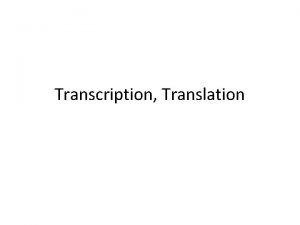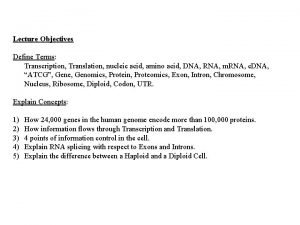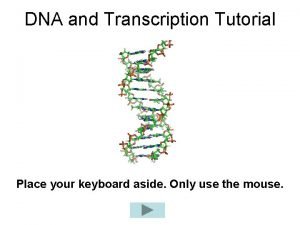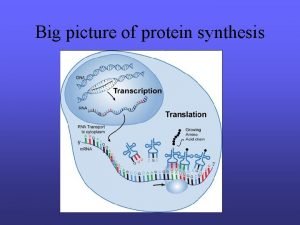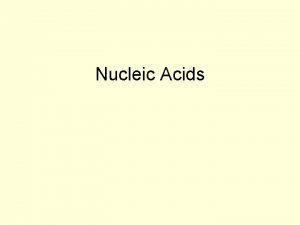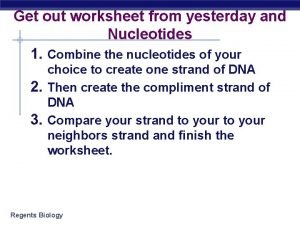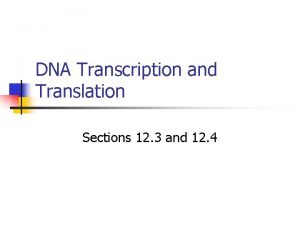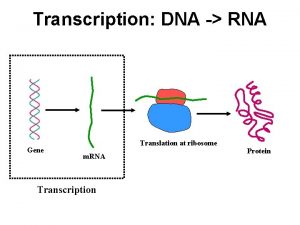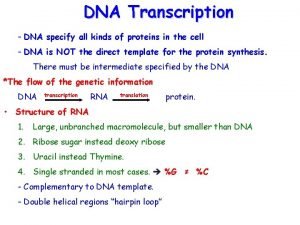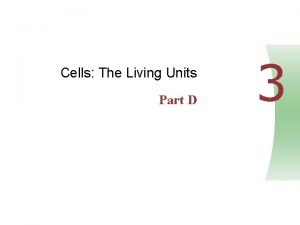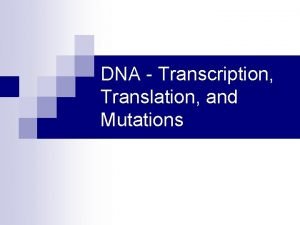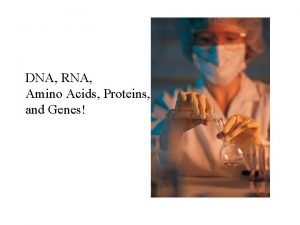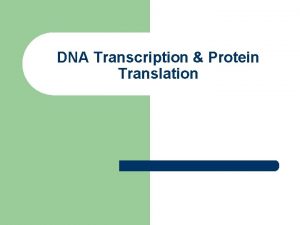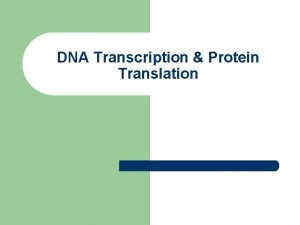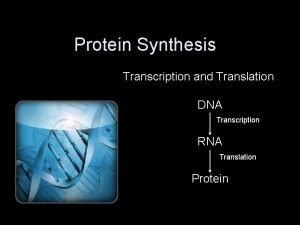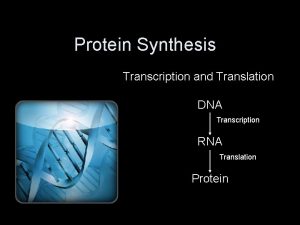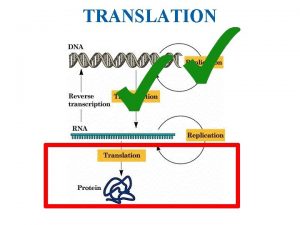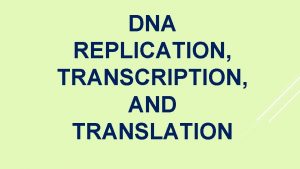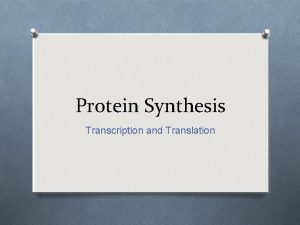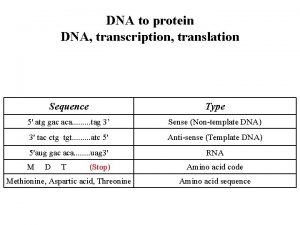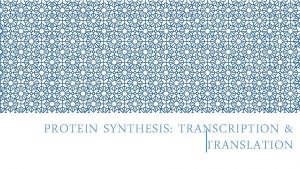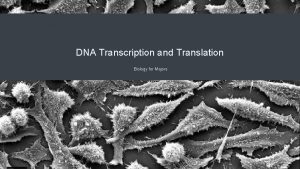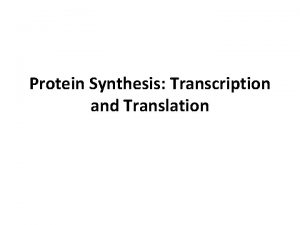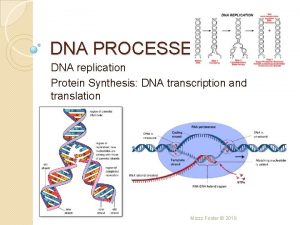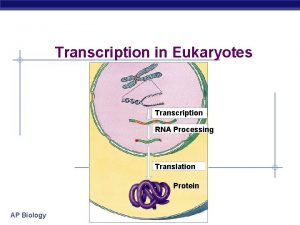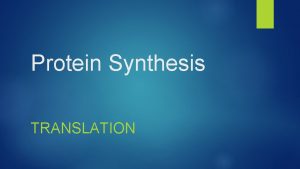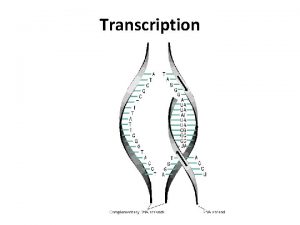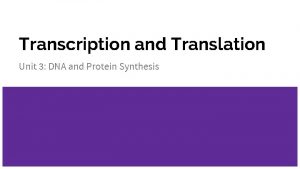Transcription and Translation From DNA to Protein Protein




















- Slides: 20

Transcription and Translation From DNA to Protein (Protein Synthesis)

Essential Questions Ø Develop a cause-and-effect model relating the structure of DNA to the functions of replication and protein synthesis Ø Explain the process of protein synthesis Ø Interpret a codon chart to determine the amino acid sequence produced by a particular sequence of bases. Ø Explain how an amino acid sequence forms a protein that leads to a particular function and phenotype (trait) in an organism. 2

From DNA to Protein ØCells differentiate based on DNA being turned on or off ØCells respond to their environments by producing different types and amounts of protein. ØWith few exceptions, all cells of an organism have the same DNA but differ based on the expression of genes. 3

From DNA to Protein ØThe sequence of nucleotides in DNA codes for proteins, which is central key to cell function and life. Ø These proteins are used for: Ø Muscle tissue Ø Walls of blood vessels Ø Enzymes Ø Hair and more! Ø In this way, DNA controls the cell http: //www. nlm. nih. gov/medlineplus/ency/images/ency/fullsize/9676. jpg 4

RNA Ø RNA is essential in the production of proteins ØUracil instead of Thymine ØSingle strand, not double strand ØU with A ØG with C ØT with A ØTACG=AUGC (DNA) (RNA) http: //www. princeton. edu/~hos/rna. gif 5

Transcription

Type of RNA ØMessenger RNA (m. RNA)- brings info. from the DNA in the nucleus of the cell to the ribosome http: //folding. stanford. edu/education/Assets/mrna. gif 7

RNA Ø Transcription: m. RNA is produced Ø m. RNA then travels out of the nucleus into cytoplasm to the ribosome ØNote: m. RNA is the same as the complimentary DNA strand (except for U instead of T) Notice: For every “A” there is now a “U” http: //www. howe. k 12. ok. us/~jimaskew/mrna. gif 8

RNA ØCodon- a sequence of 3 bases on a strand of m. RNA that codes for a specific amino acid http: //fig. cox. miami. edu/~cmallery/150/gene/17 x 3. jpg 9

Essential Questions Ø Develop a cause-and-effect model relating the structure of DNA to the functions of replication and protein synthesis 10

Translation

RNA ØTransfer RNA (t. RNA)Transports the amino acid to the site of protein synthesis at the ribosome Ø “anticodon”- 3 bases on t. RNA that complement the codon on m. RNA http: //www. engineering. ucsb. edu/~trevorc/images/tech/translation. jpg 12

RNA Ø Ribosomal RNA (r. RNA)- at ribosomes, helps build proteins out of amino acids 13

Translation Ø Takes place at the ribosomes. Ø The process of proteins being built Ø Amino acids are bonded through peptide bonds Ø Chain of amino acids forms polypeptide chain (protein molecule) 14

Essential Questions Ø Explain the process of protein synthesis 15

Types of Proteins Remember: translation= making proteins Ø make up parts of cell membrane Ø Hormones & enzymes involved in cell chemistry and communication 16

Recap: Protein Synthesis: Ø DNA → transcription(m. RNA) → translation(protein) → phenotype (expression of trait) ØNucleotide sequence in DNA codes for m. RNA sequence (codon) which determines the protein to be made ØProteins determine the phenotype of an organism ØPhenotype is the expression of a trait (what the organism physically looks like) 17

Recap: Protein Synthesis 1. m. RNA made from DNA in nucleus (transcription) 2. m. RNA takes info out of nucleus to ribosome 3. t. RNA goes and gets amino acids and brings them back to ribosome (translation) 4. Proteins made at ribosome (r. RNA) 18

Essential Questions Ø Explain the process of protein synthesis Ø Explain how an amino acid sequence forms a protein that leads to a particular function and phenotype (trait) in an organism. 19

Essential Questions Ø Develop a cause-and-effect model relating the structure of DNA to the functions of replication and protein synthesis Ø Explain the process of protein synthesis Ø Interpret a codon chart to determine the amino acid sequence produced by a particular sequence of bases. Ø Explain how an amino acid sequence forms a protein that leads to a particular function and phenotype (trait) in an organism. 20
 Transcription end result
Transcription end result Dna transcription and translation
Dna transcription and translation Dna replication transcription and translation
Dna replication transcription and translation Dna rna protein synthesis homework #2 dna replication
Dna rna protein synthesis homework #2 dna replication Dna and transcription tutorial
Dna and transcription tutorial Virusmax
Virusmax Acids and bases venn diagram
Acids and bases venn diagram Protein synthesis bbc bitesize
Protein synthesis bbc bitesize Transcription and translation
Transcription and translation Transcription and translation picture
Transcription and translation picture Transcription and translation
Transcription and translation Biology transcription and translation
Biology transcription and translation Transcription and translation practice worksheet answer key
Transcription and translation practice worksheet answer key Contrast between dna and rna
Contrast between dna and rna Transcription and translation
Transcription and translation Ribosomem
Ribosomem Dna transcription
Dna transcription Dna transcription
Dna transcription Dna to rna transcription
Dna to rna transcription Dna code
Dna code Dna transcription
Dna transcription
